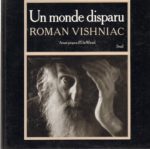Entre 1935 et 1938, le célèbre photographe Roman Vishniac a exploré les villes et les villages de l’Europe de l’Est, capturant la vie dans les shtetlekh juifs de Pologne, de Roumanie, de Russie et de Hongrie, des communautés qui semblaient déjà menacées—pas par la destruction et l’extermination, que personne n’avait prévu, mais par le changement. À l’aide d’un appareil photo caché et dans des circonstances difficiles, Vishniac a pu prendre plus de seize mille photographies; la plupart ont été laissés avec son père dans un village en France pour la durée de la guerre. Avec la publication de Children of a Vanished World, soixante-dix de ces photographies sont disponibles, trente-six pour la première fois. Le livre est consacré à un sujet que Roman Vishniac affectionne particulièrement, et celui dont il a capturé le mystère et la spontanéité avec une émotion particulière : les enfants.
Sélectionnées et éditées par la fille du photographe, Mara Vishniac Kohn, et la traductrice et co-éditrice Miriam Hartman Flacks, ces images montrent des enfants jouant, étudiant, des enfants au milieu d’un monde qui était sur le point de disparaître. Ils saisissent la vie quotidienne de leurs sujets, à la fois ordinaire et extraordinaire. Les photographies sont accompagnées d’une sélection de comptines, de chansons, de poèmes et de chants pour les jeux d’enfants en yiddish et en anglais. Grâce à l’art visuel de Vishniac et au choix par les éditeurs des vers traditionnels yiddish, une partie de cette merveilleuse culture peut être préservée pour les générations futures.
Les premiers livres de photographies de Roman Vishniac comprennent Pour leur donner la lumière : L’héritage de Vishniac romain (1995), Un monde disparu (1983), et Juifs polonais (1947).
Between 1935 and 1938 the celebrated photographer Roman Vishniac explored the cities and villages of Eastern Europe, capturing life in the Jewish shtetlekh of Poland, Romania, Russia, and Hungary, communities that even then seemed threatened—not by destruction and extermination, which no one foresaw, but by change. Using a hidden camera and under difficult circumstances, Vishniac was able to take over sixteen thousand photographs; most were left with his father in a village in France for the duration of the war. With the publication of Children of a Vanished World, seventy of those photographs are available, thirty-six for the first time. The book is devoted to a subject Vishniac especially loved, and one whose mystery and spontaneity he captured with particular poignancy: children.
Selected and edited by the photographer’s daughter, Mara Vishniac Kohn, and translator and coeditor Miriam Hartman Flacks, these images show children playing, children studying, children in the midst of a world that was about to disappear. They capture the daily life of their subjects, at once ordinary and extraordinary. The photographs are accompanied by a selection of nursery rhymes, songs, poems, and chants for children’s games in both Yiddish and English translation. Thanks to Vishniac’s visual artistry and the editors’ choice of traditional Yiddish verses, a part of this wonderful culture can be preserved for future generations.
Earlier books of Roman Vishniac’s photographs include To Give Them Light: The Legacy of Roman Vishniac (1995), A Vanished World (1983), and Polish Jews (1947).


